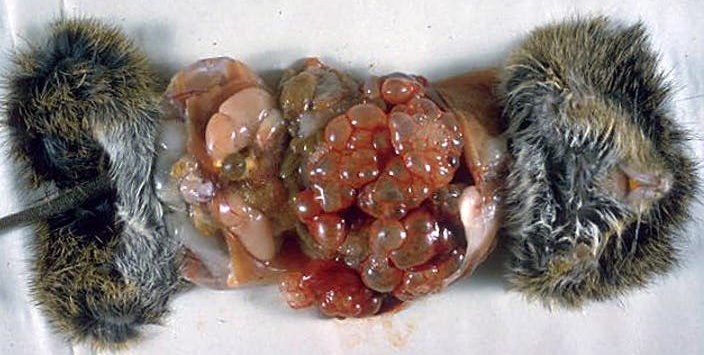
- A first-of-its-kind human case of New World screwworm has been confirmed in Maryland, linked to travel from El Salvador—proving the parasite is hitching rides into the U.S.
- The screwworm was eradicated in America by 1966 through a groundbreaking sterile fly program, but outbreaks in Mexico and Central America now threaten a costly, deadly resurgence.
- Texas is ground zero for concern, with economists warning a full-blown outbreak could wipe out $1.8 billion in livestock—cattle, deer, pets, and even humans at risk.
- The USDA is releasing millions of sterile flies and setting traps along the border, but experts fear current measures may not be enough to stop the spread.
- Natural prevention and parasite cleanses could be critical for those in high-risk areas—here’s a 10-step guide to safeguard your family and animals.
A parasite so vicious it changed the course of American agriculture
The New World screwworm (Cochliomyia hominivorax) isn’t just any parasite—it’s a biological wrecking ball. Unlike maggots that feed on dead tissue, screwworm larvae thrive on the living, burrowing deeper into wounds with every passing hour, their serrated mouths carving tunnels through muscle and organ tissue. The name "hominivorax" isn’t hyperbole—it means "man-eater." And while cattle and wildlife are its usual targets, humans are not immune. In the 1930s, this parasite was public enemy number one for American ranchers. Infestations spread like wildfire, turning healthy cattle into walking carcasses within days. The economic toll was staggering— $200 million annually in lost livestock, veterinary costs, and failed treatments. Then, in a stroke of scientific brilliance, entomologist Edward F. Knipling and his team at the USDA devised a plan: birth control for flies. By bombarding male screwworms with gamma radiation, they rendered them sterile. When released en masse, these infertile males mated with wild females, whose eggs then failed to hatch. Week after week, plane after plane dropped millions of sterile flies across Florida, Texas, and the Southwest. By 1966, the screwworm was gone from the U.S.—a victory so monumental the United Nations later called it one of the greatest achievements in animal health. But victories in nature are rarely permanent.The return of the man-eater: How a forgotten horror is slipping through the cracks
Fast-forward to November 2024. A cow at a Mexican inspection checkpoint near the Guatemala border is found teeming with screwworm larvae. A few weeks later, a traveler from El Salvador arrives in Maryland, carrying the parasite in their own flesh. The CDC confirms it: the first human case of travel-associated screwworm in the U.S. This isn’t an isolated incident. Since 2023, the screwworm has been marching northward, detected in southern Mexico for the first time in decades. The USDA is on high alert, airdropping sterile flies along the Texas border and setting traps to monitor the invasion. But the clock is ticking. "It can have a huge economic impact," warns Jennifer Koziol, an associate professor at Texas Tech School of Veterinary Medicine. "We’re talking about livestock losses, wildlife decimated, and even pets at risk." The numbers are terrifying:- $1.8 billion—potential cost of an outbreak in Texas alone.
- 10 days—how long it takes for screwworms to kill a fully grown steer.
- 3,000 eggs—what a single female fly can lay in her lifetime.
The war on the ground: Can we stop the screwworm before it’s too late?
The USDA’s strategy hinges on three pillars:- Sterile fly releases—flooding border regions with infertile males to disrupt breeding.
- Border traps—monitoring for early detection before outbreaks spiral.
- Public vigilance—urging ranchers, hunters, and pet owners to report suspicious wounds immediately.
How to protect yourself and your animals
Parasites aren’t just a problem for livestock—they’re a silent epidemic in humans, too. From tapeworms to hookworms, these invaders drain nutrients, weaken immunity, and even alter behavior. And with the screwworm’s return, now is the time to take action. Here’s a 10-step natural parasite cleanse using time-tested herbs and protocols to detox your body, support your animals, and secure your homestead. 1. Black walnut hull (juglans nigra) Why? Kills parasite eggs and larvae with its high tannin and juglone content. How? Take 500-1,000 mg daily in capsule form or as a tincture. For animals, mix powdered hull into feed (consult a vet for dosing). 2. Wormwood (artemisia absinthium) Why? Used for centuries to expel intestinal worms; contains artemisinin, which disrupts parasite metabolism. How? 200-300 mg, 2-3 times daily (avoid long-term use—it’s potent!). For livestock, steep dried wormwood in water as a drench. 3. Clove (syzygium aromaticum) Why? Destroys parasite eggs and has antiseptic properties. How? 500 mg daily or 3-5 drops of clove oil in water. For pets, crush a single clove into their food (small amounts only). 4. Pumpkin seeds (cucurbita pepo) Why? Contains cucurbitacin, which paralyzes and expels worms. How? Eat 1-2 tablespoons of raw, organic seeds daily. For livestock, grind seeds into feed. 5. Diatomaceous earth (food-grade) Why? Microscopic sharp edges cut up parasites internally (safe for humans and animals). How? 1 tsp in water daily (human dose). For animals, mix 1-2% into feed. Avoid inhaling—use a mask when handling. 6. Garlic (allium sativum) Why? Allicin kills parasites and boosts immunity. How? 2-3 raw cloves daily (crushed for maximum potency). For pets, ½ clove per 10 lbs of body weight in food. 7. Oregon grape root (berberis aquifolium) Why? Contains berberine, a natural antibiotic and antiparasitic. How? 500 mg, 2-3 times daily in capsule or tincture form. For livestock, decoct root for a medicinal wash. 8. Grapefruit seed extract (GSE) Why? Broad-spectrum antiparasitic that disrupts parasite membranes. How? 10-15 drops in water, 2-3 times daily. For animals, add 5-10 drops per gallon of drinking water. 9. Slippery elm bark (ulmus rubra) Why? Soothes intestinal lining damaged by parasites and helps expel worms. How? 1 tsp of powder in warm water, 1-2 times daily. For livestock, mix into feed as a gut-healing supplement. 10. Fasting & colon cleanses Why? Parasites thrive on sugar and stagnant waste. Starving them with intermittent fasting and colon hydrotherapy weakens their grip. How? Try a 24-48 hour water fast (consult a doctor first). For animals, withhold grain for 12-24 hours and provide fresh herbs in water. Bonus: Environmental defense for your homestead- Neem oil spray – Repels flies (including screwworms) when applied to livestock wounds.
- Apple cider vinegar – 1 tbsp in animal water daily boosts immunity against parasites.
- Companion planting – Grow pyrethrum daisies, basil, and marigolds near livestock areas to repel insects naturally.
Election chaos escalates as AfD loses SEVEN candidates to death just before German vote
By Willow Tohi // Share
By Lance D Johnson // Share
U.S. military strikes Venezuelan boat, killing 11 Tren de Aragua members
By Ramon Tomey // Share
Ukraine deploys autonomous DRONE SWARMS in combat, ushering in new era of AI warfare
By Belle Carter // Share
Obama-appointed judge releases woman who threatened to KILL President Trump
By Ramon Tomey // Share
A viral video ignites federal firestorm over Minnesota fraud
By willowt // Share
Russia activates "unstoppable" Poseidon tsunami drone
By kevinhughes // Share
Russian FM Lavrov: Moscow will back China on Taiwan issue
By ramontomeydw // Share
The breakfast clock: Why timing your morning meal is a secret weapon against high cholesterol
By jacobthomas // Share
The Health Ranger's New Year Revolution: The ultimate guide to health, wealth and freedom
By kevinhughes // Share
"Absolute Healing" on BrightU: Experts explore COVID-19 as an engineered bioweapon
By jacobthomas // Share











